Armor
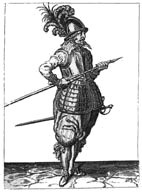 Armor on the Maryland Frontier
Armor on the Maryland Frontier
Knights of old in full suits of armor were already a distant memory when the English colonies were founded on the Atlantic frontier. By the 17th century, body armor had been reduced to a helmet, a breast and back plate and their accoutrements. This was the type of armor worn in the English Civil War. The 17th century saw the general decline and abandonment of the use of body armor by the English colonists.
Still, armor is relatively common on archaeological sites from the first quarter of the 17th century in Virginia but, to date, the only example of body armor discovered in Maryland was recovered in the excavations of Pope’s Fort in St. Mary’s City. It is part of a pikeman’s set armor in the form of a tassett, essentially a steel miniskirt that extended below a breastplate to provide protection to the upper legs and groin area. This is one of the latest documented examples of armor discovered at an early English American site.It was found in 1982 as part of a major project that located Leonard Calvert’s house. During Ingle’s Rebellion (1645-47), the Protestant rebels constructed a palisade wall and dry moat (known as Pope’s Fort) around what had been Leonard Calvert’s home.
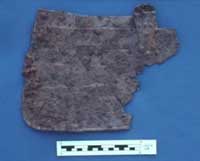 The best quality of tassetts were made of overlapping pieces (called lames), which were riveted together. This gave the armor some flexibility, which added to its comfort in wear. The tassett from Pope’s Fort is made partially of riveted lames, but also partly a solid piece that has been shaped to give the impression of lames. It attached to a metal breastplate by means of a small latch and hook.
The best quality of tassetts were made of overlapping pieces (called lames), which were riveted together. This gave the armor some flexibility, which added to its comfort in wear. The tassett from Pope’s Fort is made partially of riveted lames, but also partly a solid piece that has been shaped to give the impression of lames. It attached to a metal breastplate by means of a small latch and hook.
While some historians have suggested that armor was an anachronism when the colonies were founded, more modern scholarship suggests that plate armor, buff coats, and brigateen jackets actually were relatively effective against American Indian arrows. The conditions of battle, however, led to modifications and simplifications. Some authors have suggested that tassetts were routinely discarded to lighten the armor and provide greater mobility for fighting in a frontier setting. As bows and arrows gave way to firearms in American Indian hands, the utility of armor in general greatly diminished.
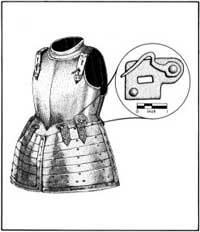 |
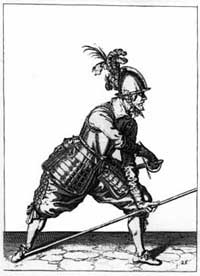 |
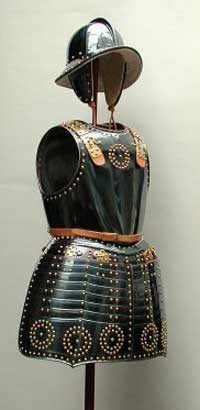 |


